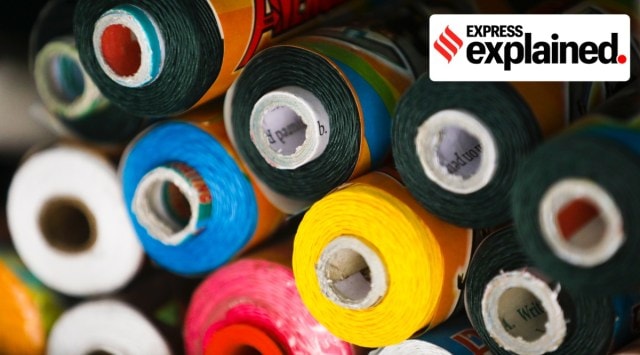Explained: The dangers and legal status of the ‘Chinese’ manjha
Around the time of Independence Day every year, Delhi's streets witness deaths and injuries due to 'Chinese' manjha. What is Chinese manjha, and where does it come from? What is the legal position of the Chinese manjha?
 Manjha thread for kites in Old Delhi. (Express Photo: Abhinav Saha, File)
Manjha thread for kites in Old Delhi. (Express Photo: Abhinav Saha, File)Every year, as Independence Day inches closer, Delhi’s streets become witness to deaths and injuries because of the ‘Chinese’ manjha.
This year, at least three motorcyclists died after the manjha either slit their throats while riding, or after it got entangled in the wheel of the bike and led to an accident. Another man was severely injured when the kite string caused cuts to his neck, but was saved in the nick of time by a passerby who rushed him to the hospital.
What is Chinese manjha?
The Chinese manjha is a glass-coated synthetic string used to fly kites. It is made of monofilament fishing lines.
According to previous submissions made to the National Green Tribunal, by the police, the Delhi government as well as various activists, monofilament strings are deadly because they are very hard to break. They are made by melting and mixing polymers, and after the strings are formed, they are then coated with glass. Stretched tight, monofilament strings have the ability to injure humans and animals alike.
Another application filed in the NGT stated that some sample strings “take more than 19,000 abrasions to break and the deadly nylon would not break but take the heads from the shoulders”.
Where does the Chinese manjha come from?
The name of the string is misleading because it is not imported from China, but is rather produced domestically. The string is made in and around UP’s Bareilly and in parts of Madhya Pradesh, from where it is mostly sold online.
The manjha from Bareilly has always been considered among the best in the country. High quality cotton thread is coated in glue rice flour and other materials to make it sharp, but it is not strong enough to injure animals or humans. Some manufacturers, however, also use powdered glass to coat the strings, making them tougher.
The main reason for the popularity of Chinese manjha, however, is the cost. It is a third of the cost of the cotton manjha and several times stronger.
What is the legal position of the Chinese manjha?
In 2016, two children died in separate but similar incidents on Independence Day, when they were looking out of the sun roof of their family cars and had their throats slit by kite string.
In the months that followed, the Delhi government passed a notification banning glass coated manjha. In 2017, after the Supreme Court asked petitioners to move the NGT, it ordered a complete ban on manjha made of nylon or any synthetic material.
The ban, however, has been tough to impose. Enforcement teams of the environment department only have a handful of members, and traders usually manage to slip through and sell the banned kite strings.
Earlier this month, during the hearing of a petition seeking a complete ban on flying, making and the sale of kites, Delhi’s standing counsel, Sanjay Lao said, “There is already a ban by the Government of NCT of Delhi and there is already a notification that this Chinese Manja is banned. There are 255 cases from 2017 onwards.”
On August 5, the Delhi High Court refused to pass any direction for a total ban on kite flying in the national capital, and instead directed the Delhi Police to ensure compliance of the National Green Tribunal order banning Chinese synthetic manjha.
- 01
- 02
- 03
- 04
- 05







































